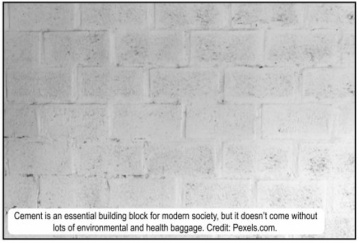
– Caren K., via e-mail
Cement is a component of concrete, mortar and other materials. It has many uses as a binding product – roads, sidewalks and patios would be very different without it. Cement production does have health and environmental risks. Manufacturing plants release sulfur dioxide, nitrogen oxide (NOx) and carbon monoxide. Also, particulate matter, lead and mercury are produced from heating limestone, which is linked to worsening asthma, heart attacks and premature death in those with heart or lung disease.
While those living near cement plants have complained for decades about health and environmental effects, complaints carry more weight with data to back them up. A scientific review published in Chemosphere in 2019 suggests an increased risk of respiratory tract cancers for those living in proximity to cement plants. Higher levels of heavy metals and indications of kidney toxicity were found in people living in areas near cement plants. The review, however, found that many scientific studies had a risk of bias, leading the U.S. Environmental Protection Agency (EPA) to study air, water and soil quality in a cluster of industrial sites where cement is produced in Dallas, Texas. “There haven’t been a lot of studies on [cumulative impact],” says the EPA’s Aimee Wilson. “So, we want to see what’s there because we don’t know.” The study concludes in July 2024, and results will be available to the public.
The environment is suffering from cement manufacturing too. The EPA reports that NOx released from the plants contributes to ground-level ozone, acid rain, poor water quality and global warming. And heavy metals carried on the wind or washed into lakes or streams when it rains can have ripple effects through the ecosystem. Another source of environmental contamination is washout containers that have flooded. These large plastic or fiberboard containers temporarily hold water and slurry washed from concrete trucks, pumps and chutes after concrete is poured. When it rains heavily, they are prone to overflow and contaminate groundwater. If you live on a property with a well, you are responsible for ensuring the safety of your own drinking water – all the more reason to be mindful of cement plants in the area.
To ensure health and environmental compliance, these facilities need to be subject to tighter regulations, including more inspections and air quality monitoring. There is also the matter of proximity – right now, a required buffer zone of 440 yards is established between homes, schools and churches. Ongoing studies like the EPA’s Dallas research will better inform guidance and policies moving forward.
If you don’t want to live near a cement plant, organize your community to fight against it. Contact your representatives to educate them on the health risks. Monitor the air quality if you cannot move or avoid a cement plant. Stay indoors and change HEPA filters on your home filtration system when air quality is poor – especially if you have health conditions like asthma or cardiac disease. If you rely on a private water well, ask local health officials about your eligibility for help paying for testing and possible repairs or filters. Get your water tested every year, at a minimum, to make sure it has not become contaminated.
CONTACTS: Pollutants emitted by a cement plant: health risks for the population living in the neighborhood, https://www.sciencedirect.com/science/article/abs/pii/S0013935103001725; Cut Carbon and Toxic Pollution, Make Cement Clean and Green, https://www.nrdc.org/bio/veenasingla/cut-carbon-and-toxic-pollutionmake-cement-clean-and-green. EarthTalk® is produced by Roddy Scheer & Doug Moss for the 501(c)(3) nonprofit EarthTalk. See more at https://emagazine.com. To donate, visit https://earthtalk.org. Send questions to: question@earthtalk.org.























